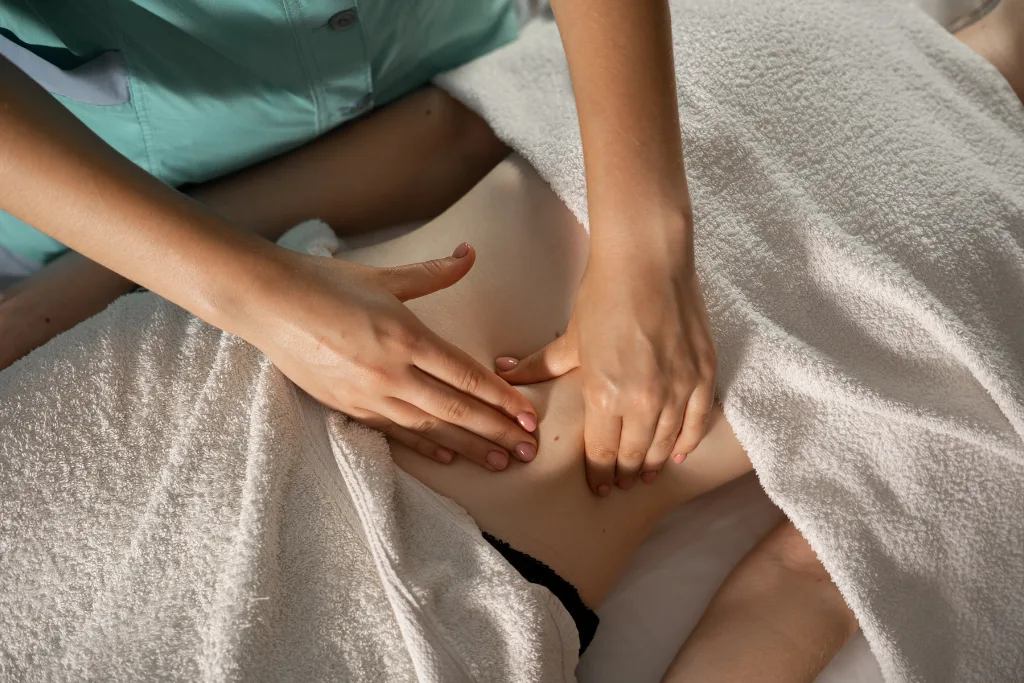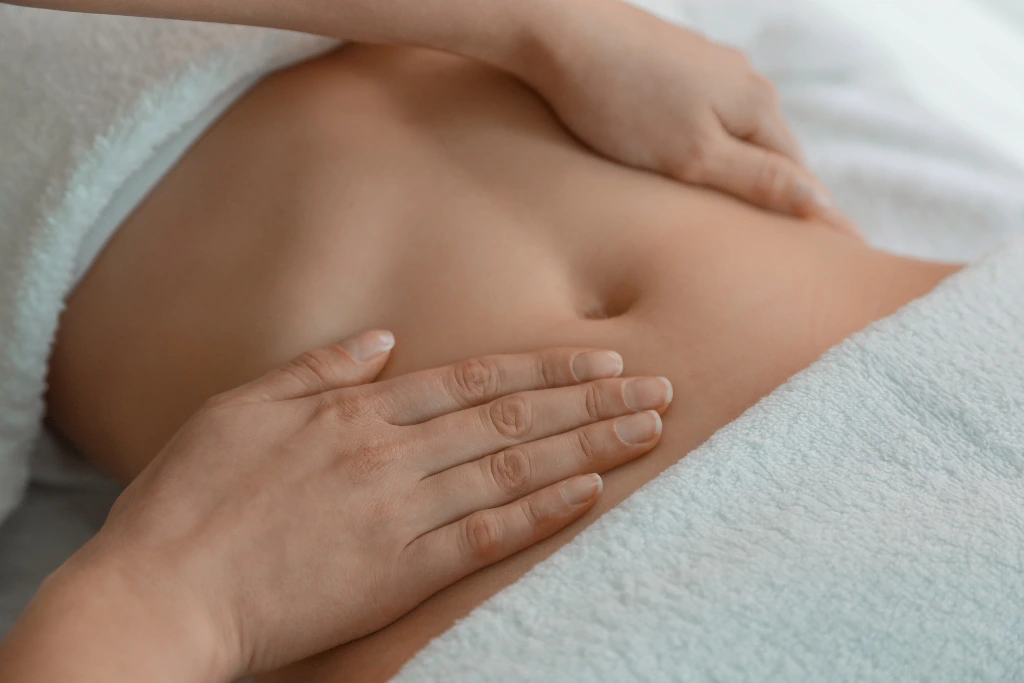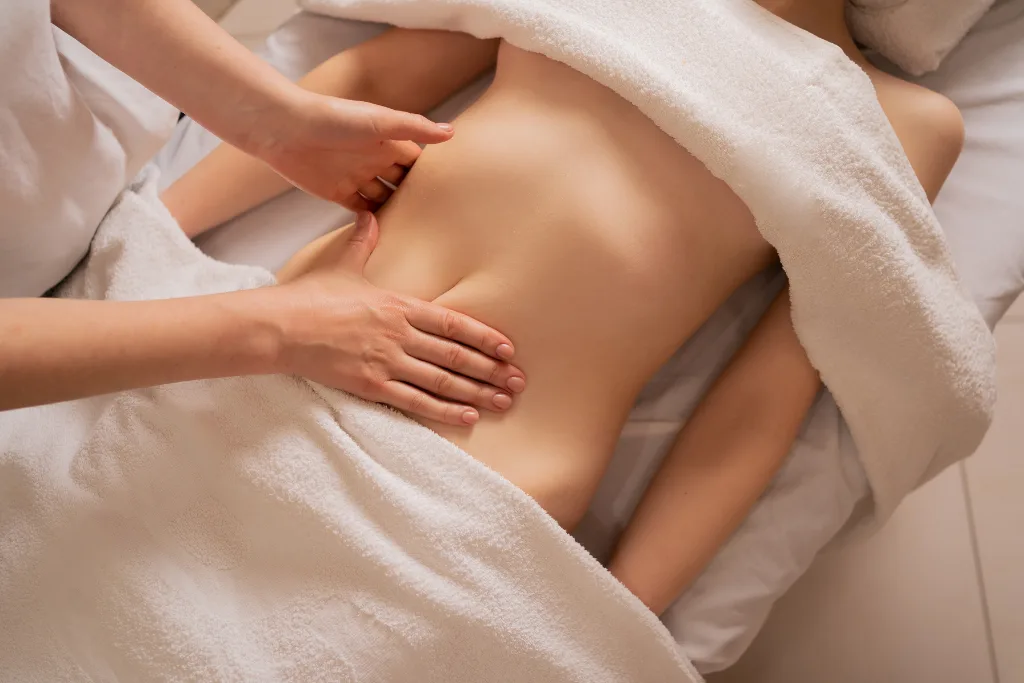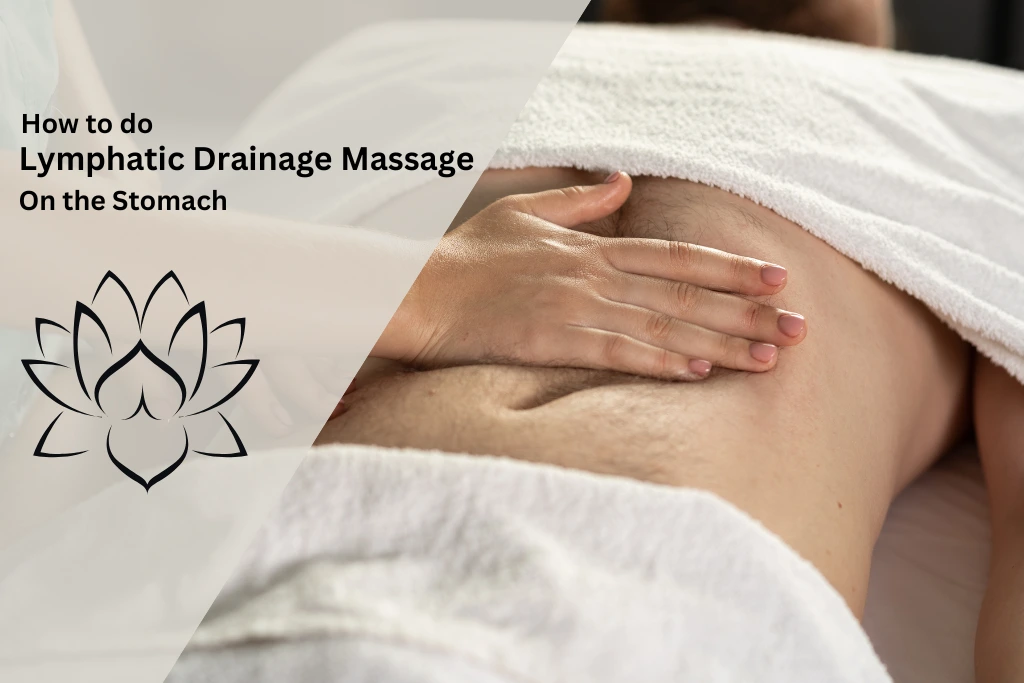So if you’re in search of a natural method for digestion to help fight off bloat and promote detoxification, lymphatic drainage on the stomach might be exactly what you’re after. The approach (not a treatment) helps discharge toxins via the lymphatic system, which in turn promotes a sense of well-being.
This complete, easy-to-implement guide explains everything you need to know about how to do a stomach lymphatic drainage massage. This post will help you kickstart your lymphatic massage practice, whether you’re a pro or a newbie to self-care.
What is stomach lymphatic drainage massage?
Lymphatic drainage massage on the stomach targets only the abdominal region. While regular lymphatic drainage may involve working on various areas of the body, stomach lymphatic drainage focuses on stimulating lymphatic flow around the stomach for improved digestion and detoxification as well as reduced bloating.
Gentle strokes are applied by following the natural rhythm of lymph fluid movement, hence stimulating the lymphatic system and supporting the body’s natural processes by eliminating waste from the body. It can relieve digestive problems, reduce bloating, and improve blood flow to the abdomen.
How It Differs from General Lymphatic Massage
Although general lymphatic drainage massage is usually done by professionals all over the body, stomach-specific lymphatic drainage can be performed at home as a self-massage at your convenience and right on your abdomen. It’s meant to relieve digestive issues and assist the body’s natural cleansing.

How Lymphatic Drainage Massage Benefits Your Stomach and Digestion
The stomach lymphatic drainage massage is not just about relaxation but also about better digestion and gut health. Now, here is how this approach can be a game changer.
Reduces Bloating
A quick reduction in bloating is one of the most immediate consequences that people feel from a stomach lymphatic drainage. It stimulates excess fluid held within the tissues to move and waste products to break down.
Improves Digestion
Lymphatic massage can improve digestion by stimulating the abdomen. Helps to remove toxins and waste by-products, making your digestive system function more effectively.
Supports Detoxification
Lymphatic massage promotes your body to clear out waste and toxins. In particular, this is beneficial for the liver and the kidneys; they filter most of the toxins from your body.
Relieves Stress and Tension
Attending to the Heart Ironically, the heart, which is exposed to immediate stress, can also manifest in the stomach (which further complicates heart disease) and convey a feeling of heaviness and discomfort and even digestive diseases. When we talk about relaxation, lymphatic massage helps us release the tension within our abdomen.
What Precautions Should You Take Before Performing Lymphatic Drainage Massage on the Stomach?
Prior to starting a lymphatic massage, certain safety precautions should be taken in order to make the process beneficial and not harmful. Most will find this massage gentle, but some need to check with a healthcare provider first if they have heart disease, kidney disease, are pregnant, have an active infection, or have unknown abdominal pain.
Lymphatic massage only needs light pressure, even in sensitive areas, so be careful not to apply too much pressure. Pass up lymphatic restorative if you happen to be pregnant unless the doctor advises it normally because you happen to be going to be sensitive in many areas at the moment. Finally, be sure to stop if anything you do causes pain or any discomfort. As you listen to your body, avoid tender areas for safety.
What Are the Steps to Perform Lymphatic Drainage Massage on Your Stomach?
Stomach lymphatic drainage is easy to do and can be done at home. Experience the full benefits of this calming yet effective practice with this step-by-step guide:
Prepare Your Space
Take a few moments to set up a space where you feel calm and at ease before starting. It is possible to do the massage on a soft surface such as a bed or mat. Make sure the room is warm and the atmosphere is peaceful for body relaxation.
What you’ll need:
- A gentle massage oil or cream (to reduce friction)
- Comfortable clothing or no clothing at all around your abdomen
- A quiet environment free from distractions
Techniques for Effective Stomach Lymphatic Drainage
You need to apply gentle pressure and rhythmic movement for good lymphatic drainage. Avoid using too much pressure; the massage needs to be gentle, calming, and slow.
- Use Gentle Pressure: The lymphatic system reacts with light, stable pressure. Do not go for deep tissue; this is to stimulate, not press into, your skin.
- Focus on Upward and Circular Motions: Start with gentle circular motions around the navel and gradually work your way outwards towards the ribcage. This promotes the upward flow of lymph towards the chest and neck.
- Maintain a Rhythm: To keep with the natural stream of lymph, maintain the strokes sluggish and rhythmic.
Key Areas of the Stomach to Focus On During Lymphatic Massage
Some areas receive specific focus to maximize lymphatic drainage when massaging the abdomen.
These include:
- Lower Abdomen: A lower abdomen rub, even below the belly button, will sweep towards the groin, the place where lymph nodes filter and process towards the physique, shorter than flowing into the pool of blood.
- Around the Navel: The area around the navel is a major lymphatic point, which is why gentle circular and “J” strokes around this area are excellent for central bloating.
- Sides of the Abdomen: Starting from the sides of the abdomen, do light strokes that go in towards the center and down to push everything towards the core and lower abdomen.
This is a way of directing fluid along natural pathways to debris that drains into lymph nodes, making the massage more effective in the treatment of bloat and supporting digestion.

What Are the Step-by-Step Instructions for Performing Lymphatic Drainage Massage on the Stomach?
Lymphatic massage starts with sitting or finding a comfortable position to lie in, preferably on something soft such as a bed or yoga mat. Take a deep breath, letting your belly relax.
Begin with Light Strokes
Lay your hands just above your belly button and, with a gentle touch, circle in a clockwise direction. It follows along with the normal movement of the digestive system, allowing for movement of lymph and relaxing the tension.
J-Stroke Technique
The “J-stroke” can also be used to encourage lymph flow. Using flat fingers, create a J on each stroke and slide gently over the abdomen downwards. This movement aims to create motion within the fluid that helps this fluid to drain towards the lymph nodes in the lower abdomen.
Moving Upward Strokes
Place your hands on your lower abdomen and very lightly sweep up toward the middle of your stomach. Do this several times to ensure you are slow and that each stroke lingers through the full motion.
Focus on Lymph Node Areas
Put your hands on the sides of your stomach and slide your hands to your groin area, where lymph nodes are. This promotes the movement of fluid towards filter and process areas of the lymph.
Complete with Gentle Circular Motions
End with a few gentle clockwise circles over the tummy. Conclude with some deep breathing, which can encourage relaxation and gentle movement of the abdominal muscles.
Light rhythmic strokes are the essential element of lymphatic drainage. Find the full guide here, but step away from deep tissue; the aim is to ensure superficial lymphatic flow rather than push deeper.
Common Mistakes to Avoid
There are some common mistakes to avoid when practicing stomach lymphatic drainage.
- Using Too Much Pressure: Excessive pressure can disrupt the natural flow of lymph and may cause discomfort.
- Skipping the Proper Direction: Always move your hands in an upward direction towards the chest, not downwards.
- Rushing the Process: Take your time with each stroke to allow the lymphatic system to respond fully.
How Much Pressure to Apply During a Lymphatic Massage on the Stomach
One of the key components of lymphatic drainage massage is pressure. You should use very light pressure, about the weight of a nickel, as the lymphatic vessels are superficial (close to the skin). When excessive pressure is applied, the massage is ineffective because the fluid does not move as desired since excessive pressure presses against the vessels rather than stimulating fluid movement. More like a gentle, soft glide rather than a shove. To connect with the skin without pushing down deeply into the underlying muscles.
How Often to Perform Lymphatic Massage on the Stomach for Best Results
So for most, a few times per week is sufficient. Others feel that just a five-minute cookie treatment gives them even more relief, especially if they usually have bloating or water retention. Try to work the massage into your routine 2-3 times weekly for maintenance, or every day if you are trying to eliminate certain symptoms. Sessions only need to be ten minutes or under to assist the lymph system and general well-being.
Post-Massage Care Tips
Those who have undergone a lymphatic drainage massage should know that going through post-care is important to maximize its effects. First is hydration—drink water so the body eliminates in a natural way the waste and toxins released during the massage. Hydration is key to the effective movement of lymph fluid as well as the removal of what has been processed by the lymph nodes.
Post-massage, feel free to rest up for a few minutes (which may allow you to relax and benefit from the treatment), but try not to have anything too heavy to eat until a while after it. That would burden your digestive system. Light stretching or gentle abdominal exercises can also help with lymphatic flow. Just follow this basic post-care routine to boost effects and feel rejuvenated.

How Can Lymphatic Drainage Massage Help with Specific Stomach Issues?
If you have a certain stomach-related problem, such as a worry stomach, it is not only for basic improvement; in any case, lymphatic kneading can soothe bloating. – undigested waste—obstruction, etc.
Lymphatic Drainage for Stomach Bloating
Bloating may also be caused by different causes, such as poor digestion, water retention or a lazy lymphatic system. Lymphatic massage can help naturally with this.
Techniques for Reducing Bloating:
- Start with gentle, clockwise circular motions on your stomach.
- Focus on the lower part of the abdomen, where bloating tends to occur.
- Move upward toward the chest, helping to guide the fluid out of the abdominal area.
How It Works: The massage stimulates the flow of different fluids and releases trapped air or gas. It also helps move the lymphatic system to help flush out excess fluid, reducing bloat.
Lymphatic Drainage for Constipation and Digestion
If you are struggling with constipation or having any digestive issues, lymphatic massage on the stomach area is great to use. It encourages digestive activity, balances the elimination process, and works to alleviate constipation.
Techniques for Supporting Digestion:
- Perform gentle strokes starting from the lower abdomen and moving upward.
- Use a combination of circular and upward strokes to help the lymph flow in the right direction.
- Focus on the sides of the stomach, where your intestines are located.
How It Works: The massage stimulates the digestive organs, which helps with the release of toxins and waste, thus relieving constipation. In addition, it helps improve nutrient absorption.
Does Lymphatic Drainage Help with Weight Loss or Belly Fat?
While lymphatic massage can’t directly eliminate belly fat, it can assist with weight management by reducing water retention, improving digestion, and supporting detoxification.
Key Points:
- Detoxification: Lymphatic drainage promotes the elimination of toxins, which helps to support the body’s natural detox system that can potentially boost metabolism.
- Water Retention: It also relieves bloating or puffiness from the stomach, making it look firmer.
- Supporting Weight Loss: Although it is not a miracle, lymphatic massage can definitely help with weight loss and in balancing fluid and digestion when combining these massages with diet and physical exercise.
How Can You Combine Lymphatic Drainage with Other Wellness Practices?
Health experts recommend combining lymphatic drainage with appropriate abdominal breathing exercises and, of course, with a diet rich in nutrients to maximize its benefits.
Pairing Lymphatic Drainage with Abdominal Breathing Exercises
Deep breathing exercises can be a useful addition to your routine to increase lymphatic output and lymph flow due to the circulation that they promote. Here’s how to do it:
- Lie Down Comfortably: Place one hand on the stomach and the other on the chest.
- Inhale Deeply: Breathe in slowly through your nose, expanding your belly. It should be your stomach that is rising, with your chest remaining still.
- Exhale Slowly: Release your breath out with your mouth open and feel your stomach drop down between your knees.
Benefits:
- Helps move lymph fluid more effectively.
- Reduces stress, which can further help with digestive health.
Lymphatic Drainage and the Benefits of a Healthy Diet
You need a healthy, lymphatic-supportive diet for true lymphatic drainage results. Consume foods that facilitate detox, like
- Fruits and Vegetables: Rich in antioxidants and fiber, they aid in inflammation reduction and help detoxify.
- Healthy Fats: Foods high in omega-3s (such as fish or flaxseeds or chia seeds) can help your lymphatic system function properly.
- Stay hydrated: You should drink sufficient water to maintain the flow of lymph fluid.
Frequently Asked Questions about Lymphatic Drainage on the Stomach
1. Can I Perform Lymphatic Drainage on My Stomach Every Day?
However, this is not advised on your own without a manual lymphatic drainage practitioner for a strong lymphatic system every day on the stomach. And while this softer style of massage is designed to promote fluid movement in the body, misuse, especially if excessive, can cause pain. The appropriate frequency for your needs can be explored with a certified manual lymphatic drainage therapist or physical therapist.
2. Does Lymphatic Drainage Help With Bloating or Gas?
Yes, lymphatic drainage massage may help relieve mild bloating or gas by encouraging fluid movement and reducing pressure in the abdomen. This massage technique targets lymph vessels and stimulates the lymph system, which plays a role in reducing inflammation and supporting digestion. Regular drainage massage can help improve circulation in certain areas of the body, including the stomach.
3. How Do I Know If I’m Doing Lymphatic Drainage Correctly?
So how do you know if you’re doing it right??? Use light, rhythmic strokes towards the armpits and collarbones, as these are the major drainage points of the lymphatic system. It should be a gentle, not deep, but not painful massage. If you are unsure, perhaps take a course from a certified lymphedema therapist or from a massage therapist who is trained in lymphatic drainage.
4. When Is the Best Time for a Stomach Lymphatic Drainage?
Your lymphatic system is more active in the morning or just after light exercise, so a stomach lymphatic massage is a great way to encourage that. By repeating this at the same time, you allow your body to make adjustments that can accelerate all the advantages of any lymphatic stomach massage, particularly the emission of toxins and the elimination of fluid retention.
5. Can Lymphatic Drainage Cause Stomach Pain or Discomfort?
If it’s your first time working with your abdomen, or if the treatment method is a bit too deep, you may experience mild gastric distress after a lymph massage. It is a gentle type of massage; if it hurts, the therapist may use the wrong pressure/technique. If the symptoms appear consistently, consult a professional and always remember where to massage.
Conclusion
Stomach lymphatic drainage massage is one of the most effective natural methods of promoting the digestive system, helping to relieve recurring bloating, improving the functioning of internal organs, and detoxifying the body. Using this simple tip as part of your self-care routine is easy once you understand the steps and tips mentioned here (this guide). Lymphatic drainage on the stomach is wonderful for those who want to ease digestive discomfort, boost circulation, or simply improve their overall wellness.

